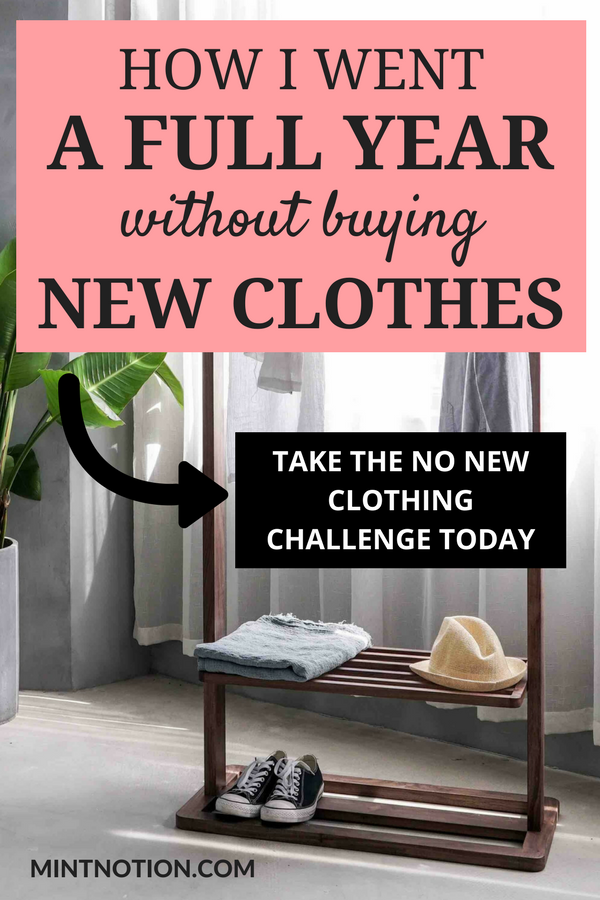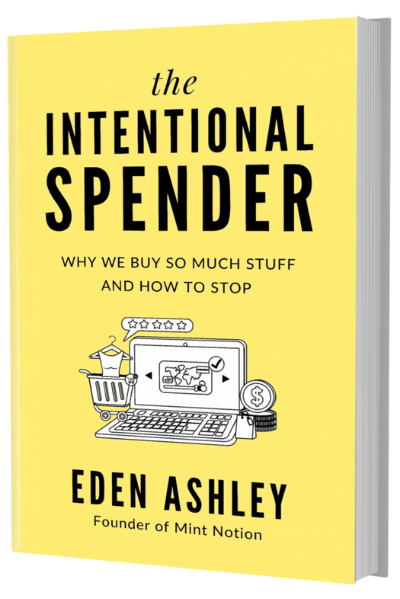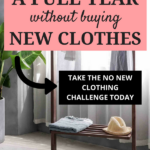Are you thinking of taking a break from not buying new clothes for a year?
When I got my first office job after finishing school, I quickly started buying more professional clothing since my previous wardrobe consisted mainly of jeans and t-shirts.
These were clothes that I initially needed for my job, but it didn’t take long before my spending habits got out of control. I was constantly finding any excuse to purchase new clothes, shoes, handbags, accessories, and so on.
I was living in a world of scarcity. I was always searching for that next item to add to my wardrobe, convincing myself that it was an investment in my image and career.
This scarcity mindset made me believe that I never had enough clothes or accessories. It drove me to become addicted to finding deals and each new purchase gave me a high.
I was buying new stuff every single week and many of these items just sat in my closet unworn or with the price tag still attached.
It wasn’t until I decided to go back to school that I finally sat down and got real about my financial situation.
I knew that I needed to save money and stop spending it on frivolous things. But it was difficult to change my spending habits and I made a few slips in the beginning.
However, I did my best to stay focused on my goal. I made a concrete goal to save “x” amount of money by a chosen date (the date I decided to quit my job) to pay for school and travel.
I wrote this goal down in my notebook and highlighted all the action steps I planned to take in order to reach my goal. Some of these action steps included:
- Automatically depositing a portion of my bi-weekly paycheck into my savings account.
- Bringing my own lunch to work (instead of eating out everyday). This was a HUGE money-saving strategy.
- Going to Starbucks only once per week (instead of everyday). I still follow this once a week Starbucks rule.
When I quit my job, I had successfully reached my savings goal. And since I was no longer making an income, it was important for me to continue finding ways to save more money and keep my living costs low.
That’s why I decided to go an entire year without buying any new clothing. This encouraged me to declutter my closet and analyze my current wardrobe.
I’m happy to say that I successfully completed the no new clothing challenge and it completely transformed my spending habits going forward.
Now instead of buying items just because I want them or they’re on sale, I try to ONLY buy items that I need. These items are usually replacing an older or worn out item. This is also known as the one in, one out rule.
For example, this year I bought a new pair of winter boots which replaced my old pair of winter boots. By making a conscious effort to get rid of an item when I buy a new item, this helps prevent clutter from piling up in my closet again.
If your goal this year is to save money, simplify your life, transition to a minimal wardrobe, change your spending habits, then I encourage you to do the no new clothing challenge. Even if it’s only for one month, it’s an eye-opening experience that’s worth trying!
Below are some tips that helped me when doing the no new clothing challenge for a year. I hope you’ll find it helpful or motivating as well!
Related Posts:
- How to declutter your wardrobe: Beginner’s guide
- 8 rules for a successful shopping ban
- I bought no new clothing for a year. This is what I learned.

Table of Contents
1. Develop the right mindset
Doing the no new clothes challenge for a year is not easy, especially for those who are used to buying new clothing on a weekly basis. In order to be successful with this challenge, you absolutely MUST develop the right mindset. Here’s how you can do this:
Step #1: Find Your WHY
I recommend writing down your goal. This goal is your WHY. It’s WHY you’re doing the no new clothes challenge.
My WHY was to transition to a more minimalist lifestyle. That’s part of the reason why I started this blog because I wanted to share my journey and tips for living a more intentional life.
What’s your WHY? Write it down and put it somewhere that’s easily visible. This can be a note on your desk, a note pinned to your inspiration board, a note tapped to your mirror, and so on.
Now you’ll be constantly reminded why you’re doing this challenge, especially on those tough days when you might feel like quitting.
Step #2: Action Plan
I also recommend writing down at least three action steps that you’re planning on taking to successfully complete the no new clothes challenge.
For example, instead of going to the mall on the weekends, find an alternative activity that is affordable and doesn’t encourage you to buy clothing. For me, I went hiking and had movie nights at home.
Step #3: Get Creative
Another great way to develop the right mindset is to think positively. Instead of opening your closet and thinking that you have nothing to wear, make an effort to mix and match outfits – even if you’ve never matched those items before.
2. Declutter and organize your closet
Yes, it may seem strange to get rid of clothes when you’re doing the no new clothes challenge, but hear me out on this one.
If you have a cluttered or disorganized wardrobe, this can actually cost you money. For example, I would often buy new clothes and not realize that I already owned something similar.
This is because my closet used to be a mess and when items are out of sight, they’re out of mind.
I was also guilty of buying accessories and wearing them only once or twice because they got buried in a drawer somewhere and I forgot that I owned them. This was a such a waste of money.
Plus, if you’re going to become a pro at mixing and matching clothing that you already own, it’s a good idea to take inventory of your closet. Here’s a quick guide on how to declutter your closet:
Step #1: Remove Everything
Take out all of your clothing and fashion accessories and put them in a pile. Chances are if you have a shopping addiction, you’ll have a fairly large wardrobe.
Step #2: Sort Items
Now there are a few different ways you can sort your clothing. To keep it super simple, you can follow Marie Kondo’s advice which is to handle each item and decide whether or not it “sparks joy”.
The idea here is to only keep items that you really love. This will make is easier to get dressed in the morning since you’ll like everything in your closet.
Donate or sell items that you no longer want. This can also be a great way to make some extra money.
Keep in mind that the goal of this step is to get your closet organized. You want to create a system that makes getting dressed easier in the morning so you can focus your energy on other activities (such as activities that bring you joy or increase your income).
Step #3: Organize Your Closet
Organize your clothing by placing like items together. For example, fold your sweaters and place them in a drawer or box.
I like to organize my closet based on the season. For example, in the winter I put my most worn clothing in the middle of my closet so it’s easy to see. This means I’ll store my summer wardrobe towards the back or sides of my closet. Then when the season changes, I’ll switch it up.
3. Repurpose and repair
I recommend finding ways to repurpose or repair items in your wardrobe. For example, instead of buying new tops for the gym, I cut off the sleeves from band shirts that I rarely wore.
This gave the shirt a new life and they were perfect for wearing to the gym or outdoors hiking in the summer.
I also found ways to repair damaged items in my closet. For example, I had an old pair of riding boots that I loved wearing in the fall and winter, but the heels had worn out.
It was tempting to buy a new pair, but instead I decided to save money by getting the heels repaired. This allowed me to wear the boots for another season before I finally needed to retire them.
If you want to learn more about how to overcome a shopping problem, check out my free audio training.
4. Wear less makeup
This tip is completely optional, but I wore less makeup when I started my shopping hiatus. I noticed that my skin cleared up (which I credit to wearing less makeup and ditching dairy) and my confidence in my natural look improved significantly.
I remember there used to be a time when I couldn’t leave the house without wearing at least mascara or lipstick. I felt so naked without wearing makeup in the beginning, but it was one of the best decisions that I made.
What does this have to do with taking a shopping hiatus? Clothing and wearing makeup used to boost my confidence.
Dressing up still feels good, but peeling back the layers and learning how to be comfortable in my own skin has helped improve my spending habits going forward.
5. Borrow clothing from family and friends
If you have a shopping addiction, it’s natural to feel the need to purchase a new outfit and accessory for each event.
For example, I used to buy several new outfits whenever I was going on vacation. I also used to purchase a new dress for each holiday party I attended or for a friend’s wedding. I used to convince myself that this was necessary.
Not anymore though. Now before vacations or special events, I shop my closet or borrow clothing from family and friends. If I’m not able to find what I need there, then I’ll consider purchasing a new outfit, provided that I can see myself wearing it for years to come.
If you feel the urge to spend money on clothing, consider hosting a swap with friends. Clothing swaps can be a lot of fun and it’s a great way to recycle and give items new life.
6. Wear everything in your wardrobe at least once
When I was decluttering my closet at the beginning of this challenge, I found it extremely difficult to get rid of anything. Whether it was my “work clothing” which I was saving for future job interviews or my “skinny jeans” which were a size too small that I was hoping to fit into someday – I had convinced myself that I needed to keep everything.
I ended up only getting rid of one small garbage bag of clothing and accessories during the beginning of this challenge. My aim was to try and wear everything in my wardrobe at least once that year to see if I really “needed” to keep it.
To make this process easy, I recommend doing this popular closet trick: Turn ALL of the hangers in your closet around (the wrong way) so the hooks are pointing towards you.
Then when you wear something, put it back in your closet with the hook facing the wall (the right way).
At the end of the challenge (which lasted one year for me), if there are any hangers still facing the wrong way, pull them out of your closet and ask yourself why you’re still holding on to it. Chances are it can be donated, sold, or thrown away.
7. Watch less TV
I used to constantly watch the news and stay up to date with popular TV shows. In fact, my old workplace had a TV with the news channel turned on all day. We would also get the newspaper delivered each morning, which I would also read over breakfast.
Watching the news all the time was depressing and there was rarely anything positive on the news. Instead it made me feel anxious and fearful.
I thought I was being a good citizen by watching the news and staying informed. But after cutting out the news for the past few years, I haven’t missed anything important. That’s because whenever there was something important to know, I would hear about it from my friends or family.
I have simplified my life by limiting how much TV I watch and it’s helped to significantly reduce my spending too.
8. Find a new hobby besides shopping
I’ll be honest with you, there are going to be some tough days when doing the No New Clothing Challenge, especially if you decide to do it for a year (like I did).
I recommend keeping a journal or even starting a blog to share your progress. This can be a great way to keep yourself motivated and to inspire others. I started this blog as a hobby to share my journey towards living a more intentional life and eventually this blog became my full-time job.
Finding a hobby that makes you happy or increases your income can help distract your mind from shopping. Spend more quality time with family and friends that doesn’t involve going to the mall.
Read next: 15 fun hobbies that make you money
9. Unsubscribe
There used to be a time where I was subscribed to all my favorite retailers and fashion magazines. I wanted to be the first to know about special promotions or get inspired by the latest trends.
But this desire to keep up to date with all the sales caused me to increase my spending and didn’t help me save any money. I highly recommend unsubscribing and stopping all magazine subscriptions before doing the No New Clothes Challenge so you won’t get tempted by special promotions and deals.
10. Set mini challenges for yourself
To help keep things feeling fresh and interesting throughout the challenge, I recommend coming up with mini challenges for yourself. Here are some examples of mini challenges that I personally did during the year of no new clothes:
- Wearing colors that you’ve never combined before in your wardrobe
- Creating a fun outfit that highlights an accessory you haven’t worn in six months
- Wearing a block of color with no pattern or prints
- Wear a top that has never been paired with this bottom
- A neutral base that’s combined with a fun print or pattern
- Wear an item of clothing that you haven’t worn in six months (or longer)
Get inspired by these mini challenges or get creative and come up with your own prompts to help utilize your wardrobe!
Introducing: The Intentional Spender

In The Intentional Spender, you’ll learn insider secrets on how to conquer your impulse spending for good. As a former shopaholic, I know all too well how emotions can easily influence your spending.
Studies show that is takes 21 days to form a habit. That’s why I’ve put together this 21-day program to help you form and implement healthy spending habits. This includes shopping with intention, living within your means while still having fun, and feeling comfortable and confident with your personal style.
I don’t believe in depriving yourself or living on a bare bones budget! I believe that you are 100% capable of transforming your mindset by discovering the root cause behind your spending habit and developing a game-plan that actually works.

